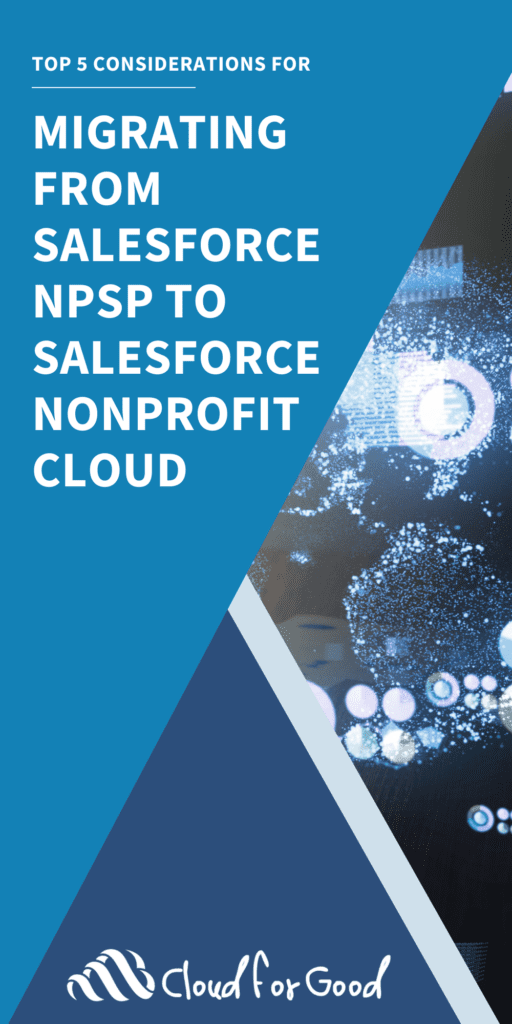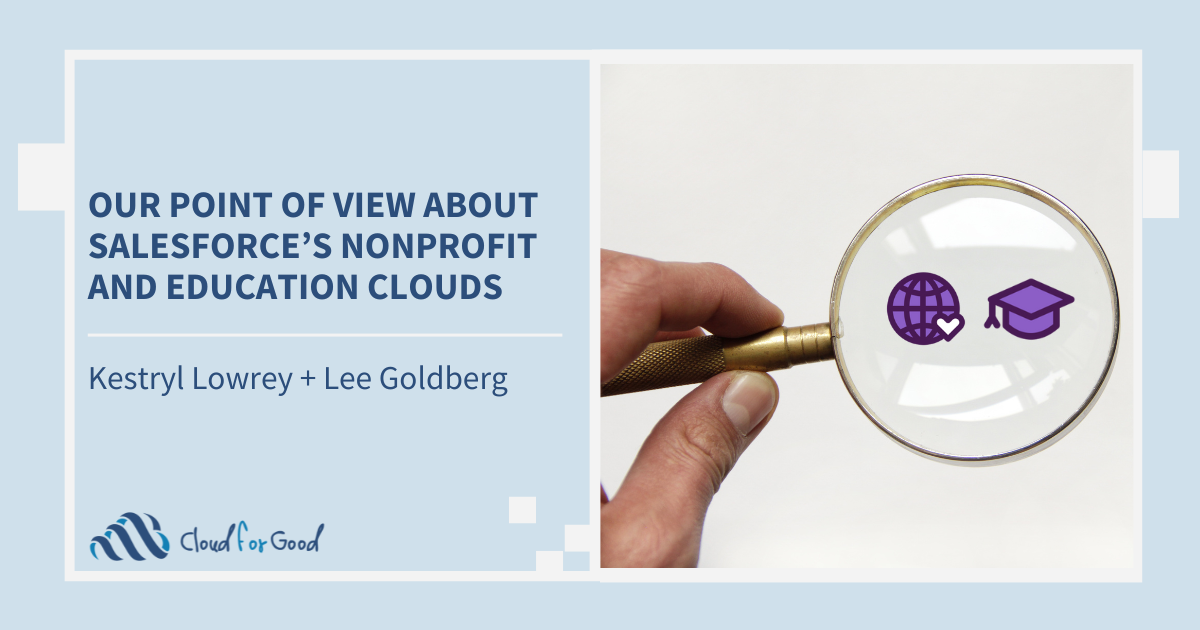A little over a year ago, Salesforce released its new vision for the Nonprofit Cloud and Education Cloud. This announcement generated lots of buzz from those around the ecosystem. As a trusted consulting firm working in the impact sectors, Cloud for Good participated as a design partner. This means we were able to get a first look at the reimagined platforms before general admission. We were able to deeply understand the data architectures and nuances before we began implementing the solution with clients.
As the solution now outpaces development over the legacy NPSP and EDA features, we’ve been working with our clients on it and helping them realize the benefits. Many of our customers are choosing the reimagined clouds to stay at the forefront of innovation, benefit from many of the proven solutions used in other industries (like Case Management taken from Public Sector Cloud), and proactively limit their technical debt.

“We are impressed by the results that Cloud for Good has delivered [on Salesforce’s Nonprofit Cloud], and we are looking forward to continuing our partnership with them. We would recommend Cloud for Good as a Salesforce partner without hesitation.”
Chief Transformation Officer
United Way Calgary and Area
As we continue to work with the Nonprofit and Education Clouds and Salesforce continues to develop and release features, we wanted to provide a look at some of the facts behind the myths and truths we’ve been hearing in the ecosystem:
1. TRUTH: The Features Being Built Core to Salesforce Means They Are Interchangeable Amongst Clouds
This is the #1 strength of Salesforce’s direction for the Nonprofit and Education technology. Any innovations across industries can be pulled from and aligned to fit Nonprofit and Education use cases. Case management, as mentioned above, was taken from the Public Sector, the Actionable Relationship Center was first used in Financial Cloud, and Education Advancement leverages features from Nonprofit fundraising. Many of these solutions have been utilized in other industries for many years, allowing the Nonprofit and Education sectors to benefit from the innovation, almost immediately.
In education, for example, organizations were encouraged to take a multi-org approach, splitting their enterprise CRM into two instances to accommodate fundraising requirements separate from the education data architecture or rely on third-party ISVs. Now, for the first time, the possibilities are endless. Institutions can either go with a multi-org managed package approach if data isn’t being shared across campus or have end-to-end constituent lifecycles from prospective applicants to current students to alumni donors contained within a single instance of Salesforce.
2. MYTH: Fundraising Features Aren’t Ready with Nonprofit and Education Clouds
While it is true that the data model for fundraising is different in Nonprofit and Education Clouds, the core functionality that organizations need to conduct business is currently surpassing feature parity with NPSP. Rather than categorizing all incoming funds as Opportunities with related Payments, the reimagined Industry Cloud utilizes a three-object model, including Gift Transactions, Gift Commitments, and Opportunities. This new model allows for simplified tracking of individual, one-off gifts on a single record (Gift Transaction), while allowing for more complex or long-term major gifts to be tracked with the overall Opportunity, Commitment(s), and related Transactions. This can ultimately reduce data storage requirements for organizations with large mass-market donor programs, as well as make it easier for fundraisers to report on and understand their data.
Some features offer greater efficiency, for example you’ll utilize the same screen for individual and batch gifts when entering your gifts. This provides greater consistency in data entry between gift types than with NPSP.
Additionally, some features improve your user experience, like the Actionable Relationship Center. This tool allows you to visualize any connected data within your system. This feature is a big improvement over the Relationship Viewer in NPSP because it allows you to extend connections beyond relationships between Contacts and can provide a comprehensive view of how your data connects.
3. IT DEPENDS: If You’re on NPSP/EDA, You Should Stick with It
This is an ROI-driven decision that will vary by organization. You’ll want to carefully evaluate if moving off the managed packages (NPSP/EDA) brings value to the organization. We released an eBook last week that helps you understand the nuances you should consider.
The answer may be no for some who are utilizing NPSP and EDA without any bumps, changes, or significant growth. However, overhauling how their organization leverages a CRM can have significant benefits for those who want to take advantage of new features or have enterprise plans for their CRM. If you decide to stay on NPSP or EDA for now, don’t forget to consider the technical debt that will accrue with any new configuration that you add to your current “legacy” org.
If you still need help deciding, implementation partners like Cloud for Good are here to help. While we believe in the transformative impact of these new Clouds, we’re also driven to support your mission. Both Cloud for Good and Salesforce want to help organizations realize the value of their technology. We’re happy to work with you to help plan your technology roadmap, whether that includes a migration now or further into the future. Contact us to schedule a time to talk about your needs.

Discover the Top 5 Considerations For Migrating From NPSP to Nonprofit Cloud, Including:
- Assessing your current Salesforce footprint,
- Reviewing the timeline for your technology transformation,
- Understanding the impact of your data,
- And more!
Want to Find Out How Complicated Your Migration From NPSP to NPC Might be?
Take the Migration Complexity Assessment.
4. MYTH: You Can’t Add Custom Fields to Standard Objects Without Being a Superuser
Indeed, many of the custom fields present in the managed packages are not included in the reimagined Clouds out-of-the-box. However, adding fields is a straightforward process for most Salesforce Admins. The idea that you can’t add a new record type or picklist value is overstated and misleading. Even within NPSP, most clients want to customize the labels, making the solution make sense for their business processes and vocabulary.
Salesforce is different because it enables technology to fit the constructs of your business processes. Managed packages, on the other hand, tend to be restrictive to organizations that want this flexibility. For example, core features from industries don’t typically impact Salesforce governor limits, while managed package automatons do. This can negatively impact performance and end user experience. Leveraging features built on core Salesforce also means having access to better support instead of being limited to agents that are knowledgeable about a specific managed package architecture.
5. MYTH: Extension Objects Are a Problem
Extension Objects are objects within Salesforce that extend another object with its own set of additional fields and triggers; however, they can be limiting as they are associated on a one-to-one basis. Cloud for Good has worked with clients extensively on evaluating whether extension objects are the right choice for them or if they need to make specific fields available on the parent object. With screen flows, OmniStudio Flex Cards, and other components, Extension Objects can be made available in a layout that seamlessly blends them with the typical record details.
Donor gift summaries are an excellent example of why we would want to use an extension object. Everyday core objects tend to be laden with automation for different purposes and user groups. Previously, by rolling up fields directly to accounts and contacts, large data volumes were processed, which would consume much of the limited system resources for automation (or would run into governor limits). With an Extension Object, you aren’t going to be triggering those calculations when making alterations to core objects. With industries entitlements like Data Processing Engine, those bulk calculations happen off server circumventing CRM imposed governor limits. Extension objects can help simplify the view of a core object while still providing users with all the data and summaries they need.
6. IT DEPENDS: Industry Clouds Are More Expensive to Implement
These reimagined Industry Clouds are designed to be customized to create a solution that makes sense for your organization. This can mean that we’ll have to build things like TDTM or some of the automation that came along with the managed packages from scratch, extending the implementation timeline.
However, many of our customers wanted that custom experience when implementing NPSP. While you are investing in the solution and the customization during the implementation, the results will be something tailored to your business processes and scalable for your organization’s growth. Additionally, the effort to customize the new clouds is balanced by the additional features that they bring out of the box that exceed what was available in NPSP or EDA, such as more robust constituent profiles, relationship views, and summary calculations.
Cloud for Good also addresses the gaps for components like TDTM and error handling framework with repeatable assets ready to be deployed during our implementation. This Utilities Library allows our customers to support the declarative admin automation they’ve come to expect from solutions like NPSP and EDA. We’ve also built a custom migration accelerator to help speed up your implementation, specifically from NPSP/EDA to the Industry Clouds, as well as accelerators to support migrating off of non-Salesforce databases such as Raiser’s Edge, Donor Perfect, Banner, BBCRM, and more. These accelerators are designed to help clients create more value with Salesforce as soon as possible by reducing time and risk in data migrations and minimizing interruptions to operations through pre-built mapping logic.
7. TRUTH: Not All Third-Party Applications are Available with Education and Nonprofit Clouds
The Industry Clouds are built on Salesforce, not on top of it. This switch comes with a different data architecture. Because of this, not all third-party applications are ready to work with the now-standard cloud objects (if they’re behind on API versions). Some of our favorites, like Blackthorn, Apsona, DonorDrive, FormAssembly, WealthEngine, Nintex, and more, are ready to work regardless of your chosen solution. The others that aren’t ready yet are quickly catching up.
8. TRUTH: New Features and Functionality Will No Longer Be Introduced On NPSP/EDA.
Managed packages are currently in maintenance mode and will no longer receive new features and functionality. The innovation and powerhouse of Salesforce’s research and development will be centered around Industry Cloud solutions.
There is currently no end-of-life associated with either EDA or NPSP. However, the lack of innovation will quickly catch up to organizations looking to scale. By considering Nonprofit and Education Cloud, you’ll limit your technology debt up front and get the new feature release channel of industry clouds sooner. Furthermore, you won’t be continuing to invest new features of your own development on an application that won’t be growing with you.
When it comes to finding the right technological solution for your organization, our best advice is to educate yourself. Look at the content from partners, but more importantly, your peers. Cloud for Good is implementing these Industry Clouds for many of our nonprofit and education customers and would be happy to tell you the stories of how this is creating efficiency for their staff by saving numerous hours a week on manual business processes, driving impact for their constituents by providing easy-to-use self-service portals and raising more funds through creating one-to-one experiences for donors and Gift Officers. We are always happy to have a conversation with you about your technology roadmap, plans for growth, and how to make sure your organization’s technology is future-ready. If you have any questions or want to talk more, please fill out the form below.





